#Bell MV-22B Osprey
Explore tagged Tumblr posts
Text
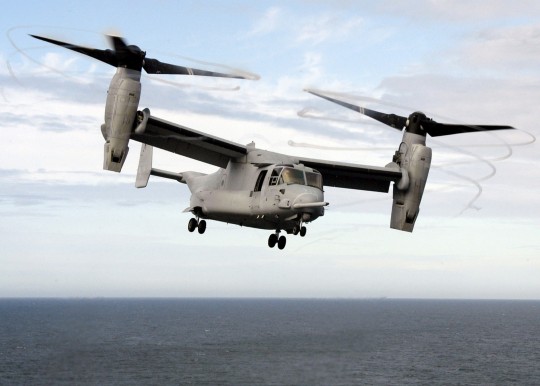
"A US Marine Corps (USMC) Bell MV-22B Osprey, Marine Tiltrotor Operational Test and Evaluation Squadron (VMX) 22, Marine Corps Air Station (MCAS) New River, North Carolina (NC), takes off from the flightdeck of an amphibious assault ship. The MV-22 is an advanced technology, vertical/short takeoff and landing multipurpose tactical aircraft, and is scheduled to replace the aging CH-46E Sea Knight and CH-53D Sea Stallion helicopters currently in service."
Photographed on November 15, 2005 by PHAN Zachary L. Borden, USN.
NARA: 6668220
41 notes
·
View notes
Text

MV-22B's assigned to USMC VMM-263 stationed at MCAS New River, NC
#USMC#Mariens#Bell#Boeing#MV-22#MV-22B#Osprey#titlrotor#transport aircraft#assault aircrat#Military aviation#aircraft
52 notes
·
View notes
Text

US Marines VMM-261 Bell-Boeing MV-22B Osprey 168347/EM-15 at Prestwick (2019)
aviationphotocompany.com/p934046062/ee9…
More V-22 images: aviationphotocompany.com/p563260206
Credit embedded
23 notes
·
View notes
Text

A Bell MV-22B Osprey sits beside a Boeing Vertol CH-46 Sea Knight on the flight deck of USS Saipan (LHA-2) on January 28, 1999.
NARA: 6611254
#USS Saipan (LHA-2)#USS Saipan#Tarawa Class#Amphibious Assault Ship#January#1999#Bell MV-22B Osprey#Bell V-22 Osprey#V-22#Tilt rotor#Boeing Vertol CH-46 Sea Knight#CH-46#Helicopter#united states navy#us navy#navy#usn#u.s. navy#my post
56 notes
·
View notes
Video
Marines MV-22B Osprey by José Luis Celada Euba Via Flickr: US Marines, Bell-Boeing MV-22B Osprey. Landing at rwy 22 Torrejon AB TOJ/LETO.
13 notes
·
View notes
Text

MV-22B Osprey The USMC replacement for the CH-46 Sea Knight series was the tiltrotor MV-22 Osprey pictured above the flight deck of a US Navy Landing Helicopter Assault (LHA) ship. Bell and Boeing had begun work on its development in 1981. The biggest advantages of a tiltrotor aircraft over helicopters are its increased speed in level flight and the ability to reach much higher altitudes.
110 notes
·
View notes
Text

-USMC MV-22 Ospreys on the deck of USS Bataan. | Photo: Staff Sgt. Wayne Campbell, USMC
Flightline: 62 - Bell/Boeing V-22 Osprey
After the disastrous failure at Desert One during the 1980 Iran hostage rescue mission, the US DOD recognized that there existed a requirement for a transport that could take off and land vertically, but also travel long distance at speed. The Joint-service Vertical take-off/landing Experimental (JVX) program was begun in 1981 to obtain and combine requirements from the Army, Navy, Marines and USAF. In late 1982 a request for proposals was released, attracting interest from Aérospatiale, Bell Helicopter, Boeing Vertol, Grumman, Lockheed, and Westland. Bell later teamed with Boeing Vertol, submitting a design based on the former’s XV-15 tiltrotor.
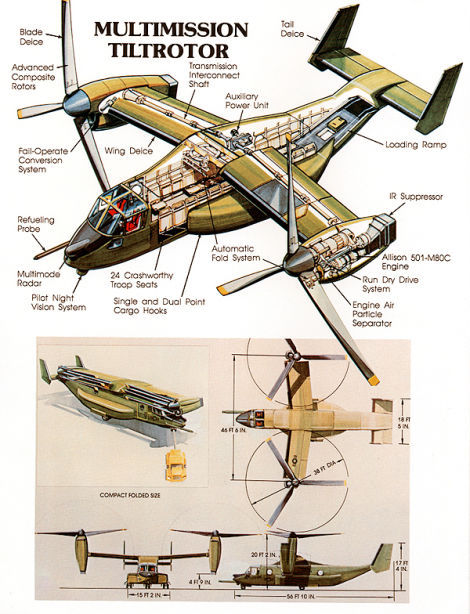
-Early concept image of V-22 Osprey, probably from mid to late-1980s. | Photo: US Navy
Bell/Boeing submitted the only design, and were awarded a preliminary design contract was awarded on 26 April 1983. In 1985 the Bell/Boeing JVX design was named the Osprey, and given the designation V-22, with USMC Osprey known as MV-22 and USAF CV-22, in part to avoid confusion with USN carrier designation (CV). By March of that year, the first half-dozen prototypes were under construction, with work split between Bell and Boeing. The first V-22 was rolled out in 1988, but the program also suffered major issues that year. Costs ballooned, from $2.5 billion in 1986 to a projected $30 billion in 1988. Citing a need to focus on other programs, the US Army dropped out of the program. The following year, the US Senate voted twice to cancel the Osprey, though the program survived. The DOD then ordered the Navy to not spend more money on the V-22, and SecDef Cheney tried several times from 1989 to 1992 to defund the program, though each time he was overruled by Congress.

-Bell-Boeing’s first V-22 prototype transitions to forward flight. | Photo: Bell/Boeing
The first of six prototypes first flew on 19 March 1989 in the helicopter mode, and on 14 September 1989 in fixed-wing mode. Sea trials were completed on USS Wasp in December 1990, though the program was marred by crashes of the fourth and fifth prototypes in 1991 and 1992. The V-22 was grounded until June of 1993 to make needed changes. From October 1992 – April 1993, the V-22 was redesigned to reduce empty weight, simplify manufacture, and reduce build costs; resulting in the V-22B variant. The existing prototypes were upgraded to the new standard, and in 1997 flight testing of the first four full-scale development V-22s began at Pax River. Testing soon fell behind schedule, though a second round of sea trials on USS Saipan was accomplished in 1999.
On 8 April 2000, a night training exercise of four MV-22 in Arizona resulted in one aircraft crashing, killing the 19 Marines on board, and another suffered a hard landing, though no one aboard were killed. The V-22 was grounded again while the crash investigation was conducted, during which issues with the V-22's design, as well as with crew training, were determined to be the causes of the crash. As the V-22 descended to land it was dropping at 2,000 feet a minute, well above the prescribed 800 feet a minute. The speed caused the aircraft to enter an aerodynamic condition known as vortex ring state. In this condition, a vortex envelops the rotor, causing an aircraft to lose lift, in essence descending in its own downwash. Flight testing resumed after the board rendered its conclusions, but another MV-22 crashed in December 2000, killing four Marines. Despite the accidents, by June 2005 the V-22 had completed its final operational evaluation, including long-range deployments, high altitude, desert and shipboard operations. In September of 2005, the Pentagon approved full-rate production of the V-22, ordering 458 aircraft (360 for the USMC, 50 for the USAF, and 48 for the Navy). The USAF officially accepted the CV-22 in 2006, and the MV-22 reaching IOC the following year. Despite being in the 2005 contract, the Navy did not acquire any of the 48 HV-22 mentioned, for reasons unknown (though likely budgetary). Ospreys have since seen deployment to both Iraq and Afghanistan, as well as other hotspots around the world.
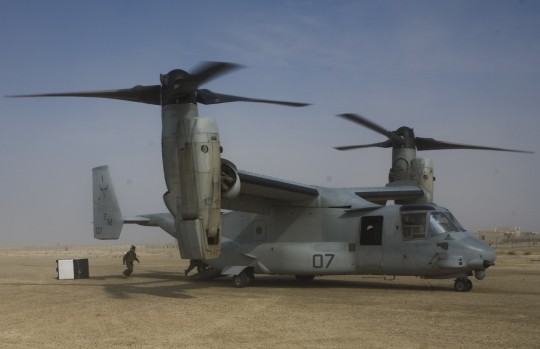
-Marines push boxes out the back of a V-22 Osprey aircraft in Zaranj, Afghanistan, on Dec. 14, 2009. | Photo: USMC

-V-22s are fitted with LEDs in the rotors, which create a glowing ring when spinning, allowing the crew, ground personnel and passengers a clear indication of the rotor disc. | Photo: USMC
In 2015, the Navy signed an MOU to buy 44 redesigned CMV-22B Osprey for COD (carrier on-board delivery) beginning in 2018, with initial delivery expected in 2020. The CMV-22 has larger sponsons, which carry additional fuel, as well as a high-frequency radio. The type will also include a hoist on the ramp, allowing it to deliver cargo to other Navy ships, replacing some helicopters.
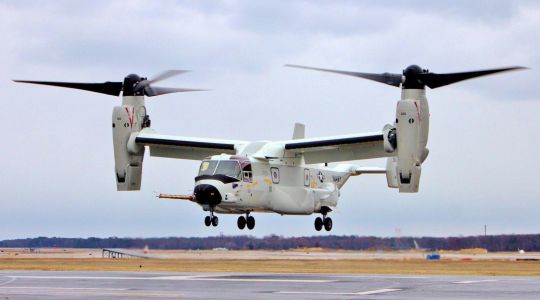
-A CMV-22B landing at Pax River after being ferried from the Bell Assembly Center in Texas. | Photo: USN
In 2014, the Japanese Self-Defence Force decided to acquire 17 MV-22Bs, with the first delivery occurring in August of 2017. The JSDF Osprey are based at Kisarazu Air Field, with plans to station some on the Izumo-class helicopter destroyers (*cough*aircraftcarriers*cough*).
India, Indonesia, Israel, South Korea and the UAE have expressed varying degrees of interest in acquiring V-22 of their own, though as of 2020 none have formally acted.
In addition to the transport versions currently in service, other variants were studied during development:
An AEW&C version known as the EV-22, which would replace the E-2 in US Navy service as well as the Sea King ASaC.7 in Royal Navy service
SV-22 Anti-submarine warfare variant, to replace the S-3 and SH-2.
Neither was pursued, though Bell/Boeing continue to pursue variants.
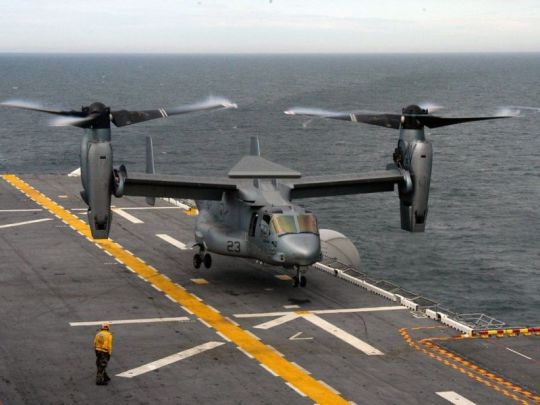
-Rendering of an EV-22 AEW variant, showing the new triangular radar pylon. | Image: Jeff Head
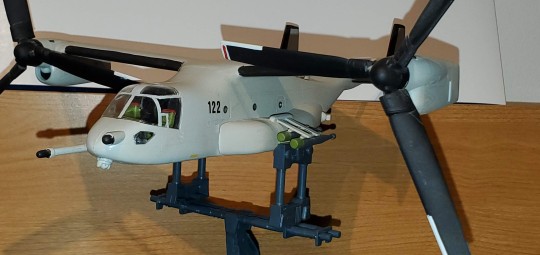
-Model of the SV-22. The ASW variant would have been armed with four torpedoes and carried a dipping sonar. | Photo: Justin Gibb
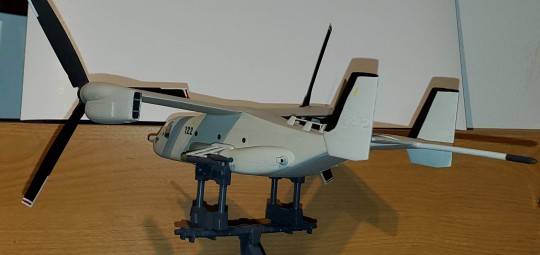
-Model of the SV-22. The proposal didn’t include a MAD boom, but I added one. | Photo: Justin Gibb
In 2017, HMX-1, the Marine helicopter squadron responsible for transporting the President, Vice President and other senior leadership, recieved 12 MV-22B, replacing its fleet of CH-46 helicopters for support operations.

-HMX-1's first MV-22B, in the squadron’s traditional gloss olive drab paint scheme. | Photo: Sgt. Rebekka S. Heite
#aircraft#aviation#avgeek#cold war#airplanes#airplane#cold war history#usaf#coldwar#aviation history#usmc#us Navy#v22#v 22#v22 Osprey#v 22 osprey#bell v22#Bell Boeing v22#cv22#mv22#tilt rotors#tiltrotor#tiltrotors
110 notes
·
View notes
Video
MV-22B Ospreys at Exeter. 10-6-2021 by Alan Wilson Via Flickr: These three Bell Boeing MV-22B Ospreys are operated by HMX-1 of the US Marines and are seen while supporting President Biden’s attendance at the G7 Summit in Cornwall. From near to far they are:- ‘168327 / 09’ c/n D0230, ‘168297 / 05’ c/n D0214 and ‘168335 / 11’ c/n D0238. Exeter Airport, Devon, UK 10th June 2021
3 notes
·
View notes
Text
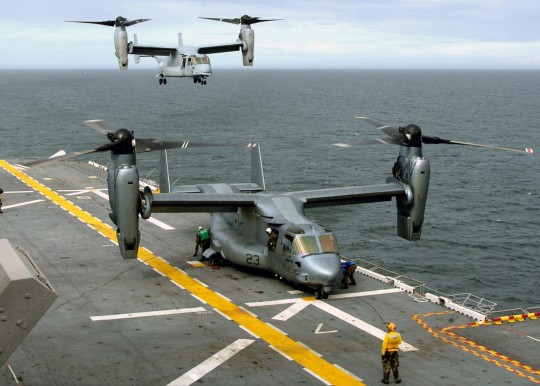
"A US Marine Corps (USMC) Bell MV-22B Osprey, Marine Tiltrotor Operational Test and Evaluation Squadron (VMX) 22, Marine Corps Air Station (MCAS) New River, North Carolina (NC), prepares to refuel while another Osprey approaches the flightdeck of the US Navy (USN) Amphibious Assault Ship USS WASP (LHD 1) for landing. The MV-22 is an advanced technology, vertical/short takeoff and landing (VSTOL) multipurpose tactical aircraft, and is scheduled to replace the aging CH-46E Sea Knight and CH-53D Sea Stallion helicopters currently in service. The WASP is currently conducting deck landing qualifications in the Atlantic Ocean."
Photographed on November 15, 2005 by PH3 Timothy Bensken, Usn
NARA: 6668221
37 notes
·
View notes
Photo
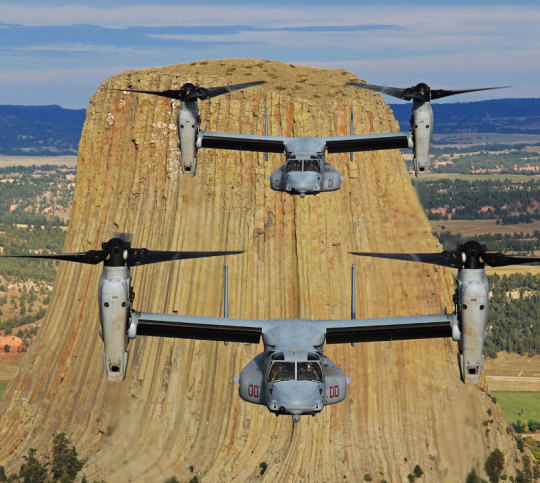
USMC MV-22 Bravos hover in front of Devils Tower, WY
#USMC#Aviation#Bell#Boeing#MV-22#Osprey#Tiltrotor#Cargo aircraft#Military transport#Utility aircraft#MV-22B#Devils Tower#Marine
209 notes
·
View notes
Text
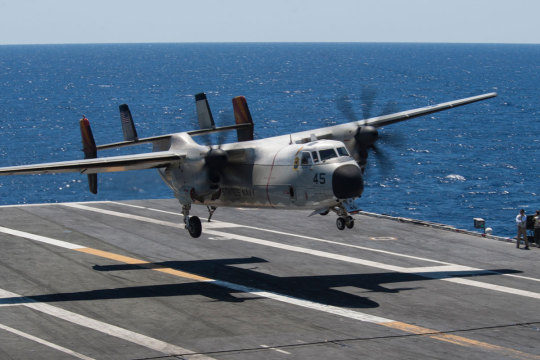
With the V-22 grounded, the Navy's venerable C-2 are coming back into action
Fernando Valduga By Fernando Valduga 12/23/2023 - 21:52in Military
Currently, there is only one tiltrotor Bell V-22 Osprey unit operating in the U.S. military. As a result, the U.S. Pacific Fleet again used the C-2A Greyhound to transport to and from aircraft carriers.
After the fall in late November of a U.S. Air Force Special Operations CV-22B near Yakushima Island, Japan, in which eight aviators died, all the Ospreys of the Navy, the Marine Corps and the U.S. Air Force were landed on December 6.
Only the Navy Middle Tiltrotor Squadron VMM-162 (part of the 26ª Navy Expeditionary Unit) flying MV-22B received special permission to conduct limited operations because it has detachments on ships currently deployed, including the USS Bataan (LHD-5) and the USS Carter Hall (LSD-50) in the Red Sea and USS Green Table (LPD-19) in the Eastern Mediterranean.
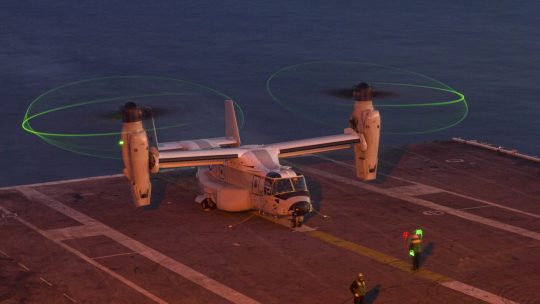
All the other Ospreys are grounded. This left some U.S. Pacific Fleet aircraft carriers without their on-board delivery aircraft (COD). Most Fleet aircraft carriers based on the West Coast began using the Osprey CMV-22B variant as CODs starting with the first deployment of the tiltrotors on the USS Carl Vinson (CVN-70) in 2021.
The CMV-22B took over the COD mission both to replace the old C-2As and to serve the Navy's F-35C. Osprey can load the Pratt & Whitney F-135 engine of the Join Strike Fighter and land with it on the aircraft carrier. Greyhound is not big enough to do that.
As a result, the C-2s that served most of the West Coast aircraft carriers in previous decades were transferred to the Norfolk Naval Station, Virginia, on the East Coast, to support the Atlantic Fleet aircraft carriers whose Air Wings do not yet have F-35C squadrons.

Currently, Vinson, USS Theodore Roosevelt (CVN-71) and USS Abraham Lincoln (CVN-72) use Osprey. On Tuesday, Vinson was operating in the Philippine Sea area, while Roosevelt and Lincoln are currently at their home port in San Diego.
youtube
TAP ARROW BUTTON TO VIEW☝️
The Japan-based USS Ronald Reagan (CVN-76) is currently in the port of Yokosuka, but is still deployed with C-2 based on land at the Iwakuni Marine Corps Air Station in Japan. Their status in port allowed the C-2 of the VRC-30 squadron based in Iwakuni to be deployed to Vinson.
First placed on the field in the mid-1960s, the C-2 overcame the first problems to become a true Navy flagship. The same cannot be said of the CMV-22B yet. The grounding that began earlier this month is the second of the U.S. Navy's Osprey fleet this year.
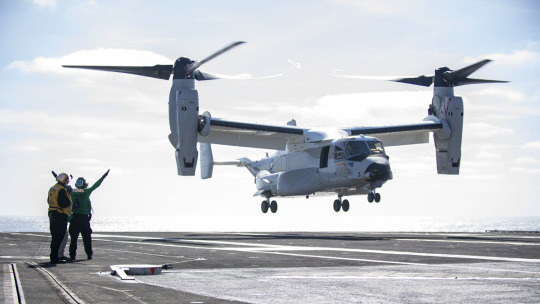
All three Forces flying on Osprey paralyzed part of their V-22 fleets in February due to an ongoing problem with the hard transmission of the tiltrotor. This grounding occurred after USAF interrupted its fleet operations in August 2022 due to the same hard transmission problem.
In 2022, the Pentagon's director of operational testing and evaluation (DOT&E) issued an evaluation stating that the CMV-22B only partially met its reliability requirements. He concluded that Osprey could not meet its operational readiness requirements and had an insufficient ice protection system.
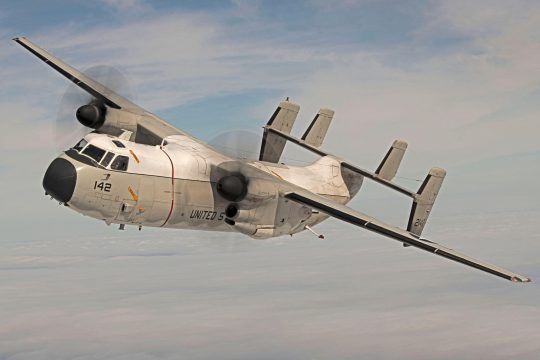
Thanks to its non-pressurized cabin, the CMV-22B cannot fly far above 10,000 feet with passengers (or practically with its crew), which means that it will probably have to fly through weather conditions in which it cannot fly easily. This has made the problem of the insufficient ice protection system more acute and the altitude limitation affects the operations and operational range of Osprey in any climate.
Meanwhile, C-2 veterans now crossing the deck to the Vinson can fly at altitudes of up to 28,700 feet and carry 10,000 pounds of cargo in a range of 1,300 nautical miles, surpassing the 6,000 pounds of cargo of the Osprey in a range of 1,150 nautical miles. The age of the C-2 also makes its maintenance difficult, but it remains a less complex aircraft than the CMV-22B.

The Navy welcomed the Osprey as a COD that can take off and land vertically from the aircraft carrier and other ships, unlike the C-2, only transported by aircraft carriers, but in practice the tiltrotor V-22 operates from a few other Navy ships besides those of amphibious assault, dock landing and transport dock ships. It is not clear whether the CMV-22B operated with these types.
Thus, in the absence of flying Ospreys, the former Navy C-2s (who are on average 34 years old) are compensating for their CMV-22 until the tiltrotors are allowed to fly again.
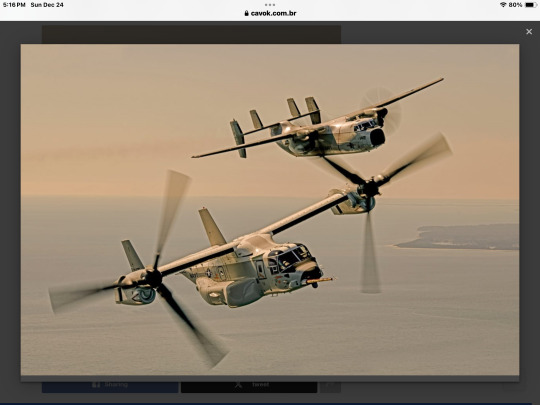
When returning to the deck of the Carl Vinson for the first time since 2021, the ship's crew will be able to reflect on the fact that the old CODs that now bring their correspondence, high-priority supplies and passengers cost approximately $38.96 million each, a third of the price of the landed CMV-22B ($104.9 million per aircraft).
Until the Ospreys receive the green light again, they will have to continue helping.
Source: Forbes
Tags: Military AviationCMV-22B OspreyGrumman C-2 Greyhoundaircraft carrierUSN - United States Navy/U.S. Navy
Sharing
tweet
Fernando Valduga
Fernando Valduga
Aviation photographer and pilot since 1992, he has participated in several events and air operations, such as Cruzex, AirVenture, Dayton Airshow and FIDAE. He has works published in specialized aviation magazines in Brazil and abroad. He uses Canon equipment during his photographic work in the world of aviation.
Related news
The first A330 MRTT of the Spanish Air Force approaching Getafe. (Photo: Juan Manuel Gibaja / Airliners.net)
MILITARY
The first Airbus A330 MRTT of the Spanish Air Force fly
23/12/2023 - 21:21
MILITARY
B-1 bombers fly in second trilateral exercise with Japan and South Korea
23/12/2023 - 17:14
MILITARY
Switzerland postpones final deliveries of Hermes 900 unmanned aerial vehicles to 2026
23/12/2023 - 16:05
MILITARY
IMAGES: RAF C-17 transports a Merlin helicopter back home
23/12/2023 - 12:08
Russian Air Force Il-18V aircraft that was intercepted by the Polish F-16s. (Photo: Polish Air Force)
INTERCEPTIONS
Polish F-16 jets are fired on a mission in the Baltic to intercept Russian Il-18V
23/12/2023 - 10:54
MILITARY
Ukrainian Air Force shot down 3 Su-34 fighter-bombers in just one day
22/12/2023 - 20:45
8 notes
·
View notes
Video
flickr
United States Marine Corps Bell/Boeing MV-22B Osprey 166687/EM/03, VMM-216, NAS Rota/LERT by Moshi Anahory
#NAS Rota#LERT#Rota Naval Air Station#United States Marine Corps#USMC#MV-22B Osprey#VMM-216#United States Air Force#USAF#U-28 Draco#Pilatus PC-12#07-711#07-0777#07-0712#168228/EM/06#166687/EM/03#166687#168228
17 notes
·
View notes
Photo

A pair of U.S. Marine Corps Bell Boeing MV-22B Ospreys from the VMM-363 “Red Lions” at Devils Tower, Wyoming.
2K notes
·
View notes
Text
BizToc | Business News
BizToc | Business News
Norway, NATO, Military aircraft, United States Marine Corps, Bell Boeing V-22 Osprey The MV-22B Osprey aircraft, assigned to the II Marine Expeditionary Force (MEF) US military unit, was “on a training mission in Nordland County, northern Norway on Friday” with a crew of four, the Norwegian Armed Forces said. Source link
View On WordPress
0 notes


